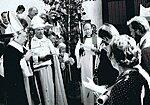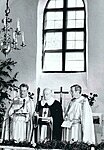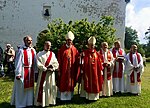Church history / Kyrkohistoria
Although Vormsi is first mentioned in historical documents only in 1391, the oldest part of the present Vormsi church, the medieval altar room, was built as early as about 1270, at the same time as Haapsalu Cathedral. This is indicated by a number of construction techniques and details that were in use at that time. However, it has not been the oldest construction stage of Vormsi Church. Probably the earliest church was built of wood and was located above the current long building. This was evidenced by the rows of stones that could be seen during the 1989 renovation work under the old floor of the church and which had been used as the foundation of the wooden church. It is still unknown when this wooden church was built. According to the tradition written in the church visitation document of 1596, the founder of St. Olaf's Church in Vormsi was the King of Denmark. The only Danish king who was in Estonia during those distant times was Valdemar II, when he went on a crusade under the future Tallinn in 1219. This year can be considered the year of construction of the oldest wooden church.
A beautiful medieval vaulted altar room was built next to this original wooden church around 1270. During the last restoration works, medieval vault paintings, which are unique in Estonia, were cleaned. Four ribbons emerge from the solar cross at the top of the vault, ending in a lotus race. The vaulted hedges show star motifs, large lily flowers and vine branches. The paintings refer to the altar room as a symbol of paradise. This style of design testifies to the connection with Gotland.
There is a small window in the southern wall of the altar room called the peephole. Through it, those who were not allowed to enter the church - those with infectious diseases (ie lepers) or those who had been expelled from the congregation - took part in the Mass. At the time when the church was closed, pilgrims could also see it through it.
The altar room also contains a copy of the medieval (2nd half of the 14th century) wooden sculpture "Virgin Mary in the child's bed", the original of which was taken to Sweden in 1944. At present, these Vormsi church assets have been deposited in the museum of St Michael's Church in Tallinn.
After the completion of the choir room until the Livonian War, the church looked quite strange in today's terms: the west side was a relatively narrow and lower log building and the east side was a higher stone altar room. However, there was nothing extraordinary about it at the time: many medieval churches by the Baltic Sea were built in this way and in this order.
During the Livonian War in the winter of 1575, the Russian tsar's troops looted the island of Vormsi over the frozen sea. Probably just then, the old log building of the church was destroyed. Balthasar Russow talks about this looting expedition in his "Livonian Chronicle".
For half a century after the war and the plague, there was probably only a looted altar room left of the church. It took time to recover from the effects of the devastating war.
The new long building of the church was completed in 1632, and with it the sanctuary got its surviving shape. As the walls of the new nave were somewhat thinner than the medieval choir builders had thought, some of the stones used to tie the nave wall were left out of the church's outer wall and are still visible today.
+++
Även om Ormsö nämns i historiska dokument först 1391, byggdes den äldsta delen av den nuvarande Ormsö kyrka, det medeltida altarrummet, redan omkring 1270, samtidigt som Hapsal domkyrka. Detta indikeras av ett antal byggtekniker och detaljer som var i bruk vid den tiden. Det har dock inte varit Ormsö kyrkans äldsta byggskede. Troligen var den tidigaste kyrkan byggd i trä och låg ovanför den nuvarande långbyggnaden. Det vittnade de stenrader som kunde ses vid renoveringsarbetet 1989 under det gamla golvet i kyrkan och som hade använts som grund till träkyrkan. Det är ännu okänt när denna träkyrka byggdes. Enligt traditionen skriven i kyrkovisitationshandlingen 1596 var grundaren av Sankt Olavs kyrka på Ormsö kung av Danmark. Den ende danska kungen som befann sig i Estland under dessa avlägsna tider var Valdemar II, när han gick på ett korståg under det framtida Tallinn 1219. Detta år kan betraktas som byggåret för den äldsta träkyrkan.
Ett vackert medeltida valvaltarrum byggdes intill denna ursprungliga träkyrka omkring 1270. Under de senaste restaureringsarbetena rengjordes medeltida valvmålningar, som är unika i Estland. Fyra band dyker upp från solkorset högst upp i valvet och slutar i ett lotuslopp. De välvda häckarna visar stjärnmotiv, stora liljeblommor och vinrankor. Målningarna refererar till altarrummet som en symbol för paradiset. Denna designstil vittnar om kopplingen till Gotland.
Det finns ett litet fönster i altarrummets södra vägg som kallas titthålet. Genom den deltog de som inte fick komma in i kyrkan - de med infektionssjukdomar (dvs. spetälska) eller de som blivit utstötta ur församlingen - i mässan. Vid tiden då kyrkan stängdes kunde pilgrimer också se det genom det.
I altarrummet finns även en kopia av den medeltida (1300-talets andra hälft) träskulptur "Jungfru Maria i barnets säng", vars original fördes till Sverige 1944. För närvarande är dessa Ormsö kyrkliga tillgångar deponerade i Svenska S:t Mikaelskyrkans museum i Tallinn.
Efter körrummets färdigställande fram till Livländska kriget såg kyrkan ganska märklig ut i dagens termer: den västra sidan var en relativt smal och lägre timmerbyggnad och den östra sidan var ett högre altarrum i sten. Det var dock inget extraordinärt med det på den tiden: många medeltida kyrkor vid Östersjön byggdes på detta sätt och i denna ordning.
Under det livländska kriget vintern 1575 plundrade den ryska tsarens trupper ön Ormsö över det frusna havet. Förmodligen just då förstördes kyrkans gamla timmerbyggnad. Balthasar Russow berättar om denna plundringsexpedition i sin "Livonian Chronicle".
Under ett halvt sekel efter kriget och pesten fanns det troligen bara ett plundrat altarrum kvar av kyrkan. Det tog tid att återhämta sig från effekterna av det förödande kriget.
Kyrkans nya långbyggnad stod färdig 1632 och med den fick helgedomen sin bevarade form. Eftersom det nya långhusets väggar var något tunnare än vad de medeltida korbyggarna hade trott, lämnades en del av de stenar som användes för att binda fast långhuset utanför kyrkans yttervägg och är synliga än idag.
In 1660, Söderby landlord Hartman Weber and his wife Catharina von Kurseln donated a pulpit to the church, which was made by Tallinn master Elert Thiele. The four pulpits depict Christ, Moses, John and Matthew. The fifth, which was lost during the transfer to Sweden in 1944, depicted Peter. The church houses a copy of the chancellery made in 1990 (the remaining 4 plaques of the original have been deposited in the museum of the Swedish St Michael's Church in Tallinn).
In 1667. Magnus Gabriel De la Gardie, the landowner of Magnushof, and his wife Countess Maria Eufrosyne von Zweibrücken of Pfalz, donated a new altar to the church of Vormsi. The altar is of the Baroque style and was made by master George Baselaque. The altar was demolished after the war, and only the painting of the upper part and a small wooden sculpture of an angel have survived till now.
Major renovations were carried out in the church in 1772 and 1829. The names and years of the masters on the window frames have also been preserved since the reconstruction of the window openings.
In 1929 the church received a new tin roof instead of the previous tarred table roof.
A short film has been preserved from 1936 where the scouts visit the church of Vormsi. The film shows the interior views of the church: we see the altar, pulpit, and various details on a large scale. The sundial can be seen in front of the church.
+++
År 1660 skänkte Söderby godsherre Hartman Weber och hans hustru Catharina von Kurseln en predikstol till kyrkan, som gjordes av Tallinnmästaren Elert Thiele. De fyra predikstolarna föreställer Kristus, Moses, Johannes och Matteus. Den femte, som gick förlorad vid förflyttningen till Sverige 1944, föreställde Peter. Kyrkan rymmer en kopia av kansliet som gjordes 1990 (de återstående 4 plaketter av originalet har deponerats i Svenska S:t Mikaelskyrkans museum i Tallinn).
År 1667. Magnus Gabriel De la Gardie, Magnushofs godsägare, och hans hustru grevinnan Maria Eufrosyne von Zweibrücken av Pfalz, donerade ett nytt altare till Ormsö kyrka. Altaret är av barockstil och gjordes av mästare George Baselaque. Altaret revs efter kriget, och endast målningen av den övre delen och en liten träskulptur av en ängel har levt kvar tills nu.
Stora renoveringar genomfördes i kyrkan 1772 och 1829. Mästarnas namn och årtal på fönsterbågarna har också bevarats sedan ombyggnaden av fönsteröppningarna.
1929 fick kyrkan ett nytt plåttak istället för det tidigare tjärade brädstaket.
En kortfilm finns bevarad från 1936 där scouterna besöker Ormsö kyrka. Filmen visar kyrkans inre vyer: vi ser altaret, predikstolen och olika detaljer i stor skala. Vi kan see soluret framför kyrkan.
The ensuing World War II also left a deep mark on the history of Vormsi island. The natives of Vormsi left the island. The people who settled on the island after the war, who were also predominantly Lutheran, wanted to continue the church and worship in the church. The Soviet occupation authorities did not allow the church to continue. In the following years, the church was therefore left unattended and looted. During the collective farm, the church was occasionally used as a storehouse for grain, hay and potatoes. At that time, the historical pastorate of Vormsi was also destroyed.
+++
Det efterföljande andra världskriget satte också djupa spår i Ormsö öns historia. Infödingarna på Ormsö lämnade ön. De människor som bosatte sig på ön efter kriget, som också var till övervägande del lutherska, ville fortsätta kyrkan och gudstjänsten i kyrkan. De sovjetiska ockupationsmyndigheterna tillät inte kyrkan att fortsätta. Under de följande åren lämnades därför kyrkan obevakad och plundrad. Under kollektivbruket användes kyrkan tidvis som förråd för spannmål, hö och potatis. Då förstördes även Ormsö historiska pastorat.
Again, almost half a century passed before the church could be restored. In the summer of 1988, the local Christians of Vormsi began the restoration of the church. Assistance for this was received from the local authorities of Lääne County and also from former Vormsi residents in Sweden. Donations and help for this work came from thousands of people from Estonia, Sweden and Finland.The restored church was rededicated on St. Olaf's day, July 29, 1990. The congregation of St. Olaf in Vormsi was restored in 1989.
+++
Återigen gick det nästan ett halvt sekel innan kyrkan kunde restaureras. Sommaren 1988 påbörjade de lokala kristna på Ormsö restaureringen av kyrkan. Stöd för detta fick man från kommunerna i Lääne län och även från tidigare Ormsöbor i Sverige. Donationer och hjälp till detta arbete kom från tusentals människor från Estland, Sverige och Finland.
Den restaurerade kyrkan återinvigdes på S:t Olavs dag, den 29 juli 1990. S:t Olafs församling på Ormsö restaurerades 1989.
Vormsi pastors / Ormsö pastorerJohannes Duuell 1539
Kersten 1543-1567
Sigfrid 1567
Herman Erkenstamm 1576
Magnus Blomer 1586
Sigfrid Georgii Forsius 1593-1596
Johannes Henrici Schäffer 1610-1636
Jonas Stephan Mystadius 1638-1688
Peter Herlin 1680-1688
Georg Johan Gillaeus 1689-1695
Laurentius Malm 1695-1710
Johan Nygren 1710-1711
Laurentius Naezenius 1712-1717
Mattias Hysing 1717-1735
Andreas Hollming 1736-1769
Johan Matthias Orning 1769-1805
Nicolaus Nils Malmgren 1805-1829
William Alexander Nordgren 1830-1858
Jacob Eduard Petersen 1859-1868
Alexander Wilhelm Lyra 1869
Julius Alexander Nordgren 1869-1902
Veinö Melin 1902-1917
John August Klasson 1921-1929
Karl Nikolaus Nilsson 1929-1934
Hjalmar Pöhl 1934-1944
Ivar Pöhl 1937-1944
Tiit Salumäe (caretaker pastor 1989-2017)
Ants Rajando 1992- (1992-2017 deacon)
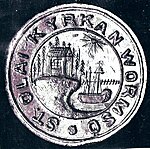
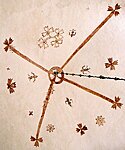


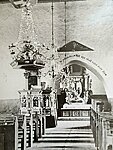
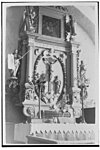


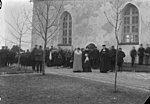
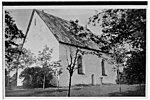
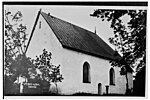
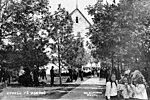

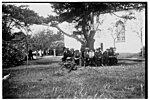
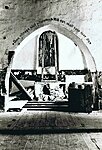
_medium.jpg)
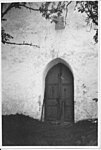
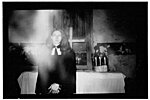
_medium.jpg)

